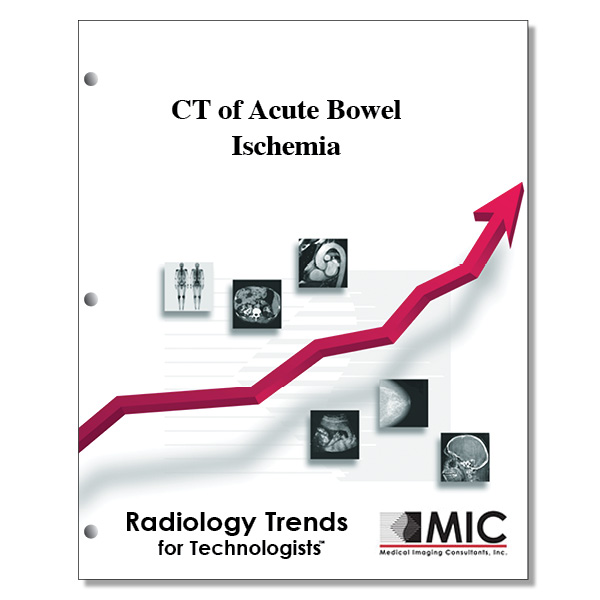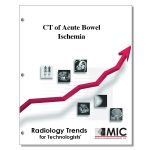

CT of Acute Bowel Ischemia
CT of the ishemic bowel is presented including pathology, techniques and anatomy.
Course ID: Q00074 Category: Radiology Trends for Technologists Modalities: CT, Radiography4.0 |
Satisfaction Guarantee |
$39.00
- Targeted CE
- Outline
- Objectives
Targeted CE per ARRT’s Discipline, Category, and Subcategory classification:
[Note: Discipline-specific Targeted CE credits may be less than the total Category A credits approved for this course.]
Computed Tomography: 4.00
Procedures: 4.00
Abdomen and Pelvis: 4.00
Registered Radiologist Assistant: 4.00
Procedures: 4.00
Abdominal Section: 3.00
Neurological, Vascular, and Lymphatic Sections: 1.00
Vascular-Interventional Radiography: 2.00
Procedures: 2.00
Vascular Diagnostic Procedures: 2.00
Outline
- Introduction
- Anatomy and Physiology
- Etiology and Pathogenesis
- Pathology
- CT Role
- Value
- Technique
- Findings
- Bowel Wall Thickening
- Dilatation
- Stranding and Ascites
- Bowel Wall Attenuation
- Abnormal Enhancement
- Pneumatosis and Portomesenteric Gas
- Pitfalls
- Conclusion
Objectives
Upon completion of this course, students will:
- understand the causes of bowel ischemia
- be familiar with which bowel diseases are potentially fatal conditions
- understand what acute transmural bowel ischemia involves
- know the anastomotic connections between the SMA and IMA
- be familiar with the branches of the abdominal aorta
- be familiar with the vascular supply of the large and small bowel
- understand the blood supply the celiac axis provides
- know what the superior mesenteric artery provides blood to
- know what the Inferior mesenteric artery provides blood to
- be familiar with the layers of the intestine
- be familiar with what vessel the Inferior mesenteric vein drains into
- be familiar with what vessel the superior mesenteric vein drains into
- know the percentage of cardiac output that supplies the bowel
- understand to which layer of the bowel the majority of blood supply goes
- understand what happens to the blood supply to the bowel following eating
- know what factors can decrease blood supply to the bowel
- be familiar with the most common causes of acute bowel ischemia
- understand the characteristics of partial mural bowel wall ischemia
- be familiar with the localized complications of bowel ischemia
- know the localized complications of bowel ischemia
- be familiar with what are not systemic complications of bowel ischemia
- know the systemic complications of bowel ischemia
- know the most common origin of the embolism for acute occlusions of the SMA
- be familiar with the most common cause of SMA occlusion
- be familiar with the characteristics of mesenteric vein occlusions
- know the conditions that lead to bowel ischemia
- know the causes of non-occlusive ischemia
- be familiar with the cause of occlusive bowel ischemia
- understand the characteristics of stage I bowel ischemia
- understand the characteristics of stage III bowel ischemia
- know during which Stage partial mural bowel ischemia occurs
- know which stage of acute bowel ischemia is associated with a high rate of death
- be familiar with what condition bowel wall necrosis is followed by
- know how various bowel disease states appear in the presence of contrast agents
- know what types of contrast agents to use when evaluating CT of bowel ischemia
- understand the timing of contrast enhancement when evaluating CT of bowel ischemia
- know the proper dosage of IV contrast
- understand how long following the injection of IV contrast the portal phase occurs
- understand how long following the injection of IV contrast the arterial phase occurs
- be familiar with what pathology can be seen on a high quality venous phase scan
- know what bowel wall changes can be seen on CT
- understand the reasons for not administering contrast agents
- know the causes of bowel wall thickening in patients with acute bowel ischemia
- know the normal range for bowel wall thickness
- know the most common CT finding in bowel ischemia
- understand the least specific CT finding in bowel ischemia
- understand the least common CT finding in bowel ischemia
- list the extra-intestinal CT findings secondary to bowel ischemia
- be familiar with the most specific CT finding in bowel ischemia
- understand the CT finding which indicates a good prognosis
